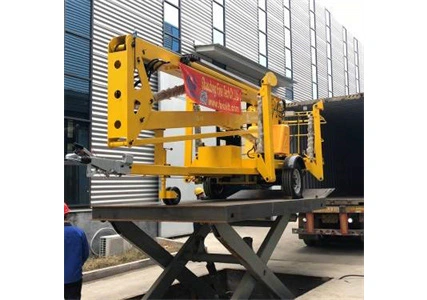An electro hydraulic scissor lift, powered by a motor, drives a hydraulic pump, which converts hydraulic energy into mechanical energy. This drives the scissor mechanical structure to perform lifting operations. Its working principle mainly relies on the pressure of hydraulic oil to push the scissor arms to unfold and fold, thereby achieving the lifting and lowering of the platform.
Advantages of Foru's Electro Hydraulic Scissor Lift
Fast Lifting
The electro hydraulic scissor lift adopts electric hydraulic drive, which has a simple structure and small size. Therefore, the lifting and lowering speed is relatively fast, capable of quickly responding to operational needs and improving work efficiency. This characteristic makes it advantageous in situations where quick lifting operations are required.
Stable Structure
After lifting, the hydraulic scissor lift platform is highly stable. All four corners bear the weight simultaneously, ensuring that the items on the load-bearing platform remain steady without sliding or shaking, thereby ensuring operational safety.
High Load Capacity and simple electrical isolation measures.
Simple Construction Requirements
Apart from the embedded stress requirements at the bottom of the pit, there are no other construction needs.
Working Principle of Foru's Electro Hydraulic Scissor Lift
Power System Start-up
When the motor starts, the hydraulic pump begins to work. The hydraulic pump draws hydraulic oil from the tank and forms a certain pressure.
Hydraulic Oil Transmission
High-pressure hydraulic oil passes through the oil filter, explosion-proof solenoid directional valve, throttle valve, hydraulic control check valve, balance valve, and other control components and enters the lower end of the lift cylinder (or oil cylinder). These control components play the role of regulating pressure, flow, and protecting the equipment in the hydraulic system.
Platform Lifting
After the hydraulic oil enters the lift cylinder, it pushes the piston inside the cylinder to move upwards. The upward movement of the piston drives the lifting platform to rise through the unfolding of the scissor support frame. The scissor support frame consists of two or more hydraulic scissor mechanisms forming fork arms. These fork arms unfold under the push of hydraulic oil, lifting the platform. Conversely, when the hydraulic pump stops working or the control valve changes direction, the hydraulic oil flows back to the tank from the upper end of the lift cylinder, the piston descends, the scissor support frame folds, and the lifting platform descends as well.
Smooth Control
To ensure the smoothness of the lifting process, balance valves and throttle valves are set in the hydraulic system. The balance valve is used to maintain the pressure in the circuit, ensuring the descent speed is not affected by the weight of the load and remains smooth. The throttle valve is used to regulate flow, thereby controlling the lifting speed.
Precautions
Observations for Operators When Pressing the Button
Check whether the load is placed at the center of the workbench. If not, urge the relevant personnel to adjust it.
After pressing the button, check if the workbench responds accordingly. If not, immediately press the "Stop" button and check if the power line is missing a phase to avoid motor burnout.
Observations for Operators During Platform Lifting and Lowering
Observe whether there is oil leakage or seepage in the hydraulic oil circuit.
Check if there are any abnormal noises in each rotating part. If so, take appropriate action and replace severely worn parts promptly.
Check if there are any abnormal noises from the hydraulic pump. If there are, handle them promptly.






































